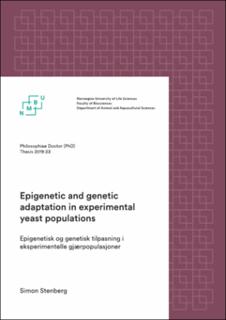| dc.contributor.advisor | Våge, Dag Inge | |
| dc.contributor.advisor | Warringer, Jonas | |
| dc.contributor.advisor | Omholt, Stig W | |
| dc.contributor.advisor | Gjuvsland, Arne B | |
| dc.contributor.author | Stenberg, Simon | |
| dc.date.accessioned | 2022-12-19T08:46:33Z | |
| dc.date.available | 2022-12-19T08:46:33Z | |
| dc.date.issued | 2019 | |
| dc.identifier.isbn | 978-82-575-1586-7 | |
| dc.identifier.issn | 1894-6402 | |
| dc.identifier.uri | https://hdl.handle.net/11250/3038386 | |
| dc.description.abstract | Evolution is a highly complex process where life change over time by the influence of relatively simple forces. Bringing evolution into the lab is a valuable asset to answer questions about processes that shape evolution. What determines how populations adapt to changing environments? To what degree can we predict evolutionary outcomes? How fast can populations adapt to a novel environment? I have utilized and contributed to the develop- ment of an experimental evolution platform using a combination of modern tools to answer fundamental questions about adaptive evolution using the baker’s yeast Saccharomyces cerevisiae as a model. In Paper I, we showed how the concerted improvement of genetically independent fitness components can be used as a signature of natural selection, disclosing selection pressures to which adaptation has occurred. Accordingly, we reported adaptation of natural yeast lineages to diverse nitrogen niches and pinpoint the mutations underlying this diversity. In Paper II, we let yeast evolve in the lab in order to study if fast adaptation can be explained without invoking epigenetics. By comparing our results to data-driven simulations we found that fast adapta- tion to arsenic could be explained by pleiotropy of fitness components and slightly elevated mutation rate without invoking epigenetic explanations. In paper III we performed massively parallell experimental evolution in order to probe the stability of adaptation and identified reversible adaption to oxidative stress, through mitochondrial DNA erosion. Chronic stress led to genetic assimilation of adaptation by complete degradation of mitochondrial DNA. Overall, these findings illustrate the power of experimental evolution as a tool to understand evolution. | en_US |
| dc.description.abstract | Evolusjon er en svært kompleks prosess der levende organismer endres over tid som følge av relativt enkle krefter. Evolusjon inn i laboratoriet er et et verdifullt verktøy i arbeidt med å gi svar på noen grunnleggende spørsmål rundt evolusjon. Hva bestemmer hvordan populasjoner tilpasser seg endrede miljøbetingelser? I hvilken grad kan vi forutsi resultatet av evolusjon? Hvor fort kan populasjonener tilpasse seg et helt nytt miljø? Jeg har anvendt og videreutviklet en plattform for eksperimentell evolusjon som utnytter moderne labmetoder for å svare på grunnleggende spørsmål om adaptiv evolusjon i modellorganismen gjær (Saccharomyces cerevisiae). I artikkel I viste vi hvordan samvariasjon i genetisk uavhengige fitnesskomponenter kan brukes som en signatur på naturlig seleksjon for å avdekke hvilke se- leksjonstrykk som har ført til adaptasjon. Vi avdekket adatasjon av naturlig forekommende gjærstammer til ulike nitrogenkilder og finkartla de kausale mutasjonene som har gitt opphav til den diversiteten vi ser. I artikkel II brukte vi labevolusjon av gjær til å studere om hurtig tilpassning kan forklares uten å ty til epigenetiske mekanisker. Vi sammenholdt eksperimentelle resultater med datadrevne simuleringer og fant at rask adaptasjon til arsenikk kunne forklares uten epigenetikk, dersom man forutsetter pleiotropi for fitnesskom- ponetner og noe forhøyet mutasjonsrate. I artikkell III gjorde vi stor-skala paralell eksperimentell evolusjon for undersøke hvor stabile tilpasningene var og avdekket reversibel adaptasjon til oksidativt stress, gjennom delvis nedbryting av mitokondrielt DNA. Vedvarendende stress førte til genetisk assimilering ved fullstending nedbryting av mitokondrielt DNA. Disse resul- tatene illustrere at eksperimentell evolusjon er et kraftfullt verktøy for å forstå evolusjon. | en_US |
| dc.language.iso | eng | en_US |
| dc.publisher | Norwegian University of Life Sciences, Ås | en_US |
| dc.relation.ispartofseries | PhD Thesis;2019:23 | |
| dc.rights | Attribution-NonCommercial-NoDerivatives 4.0 Internasjonal | * |
| dc.rights.uri | http://creativecommons.org/licenses/by-nc-nd/4.0/deed.no | * |
| dc.subject | Experimental evolution | en_US |
| dc.subject | Yeast | en_US |
| dc.subject | Mitochondria | en_US |
| dc.subject | Adaptation | en_US |
| dc.subject | Epigenetics | en_US |
| dc.title | Epigenetic and genetic adaptation in experimental yeast populations | en_US |
| dc.title.alternative | Epigenetisk og genetisk tilpasning i eksperimentelle gjærpopulasjoner | en_US |
| dc.type | Doctoral thesis | en_US |

